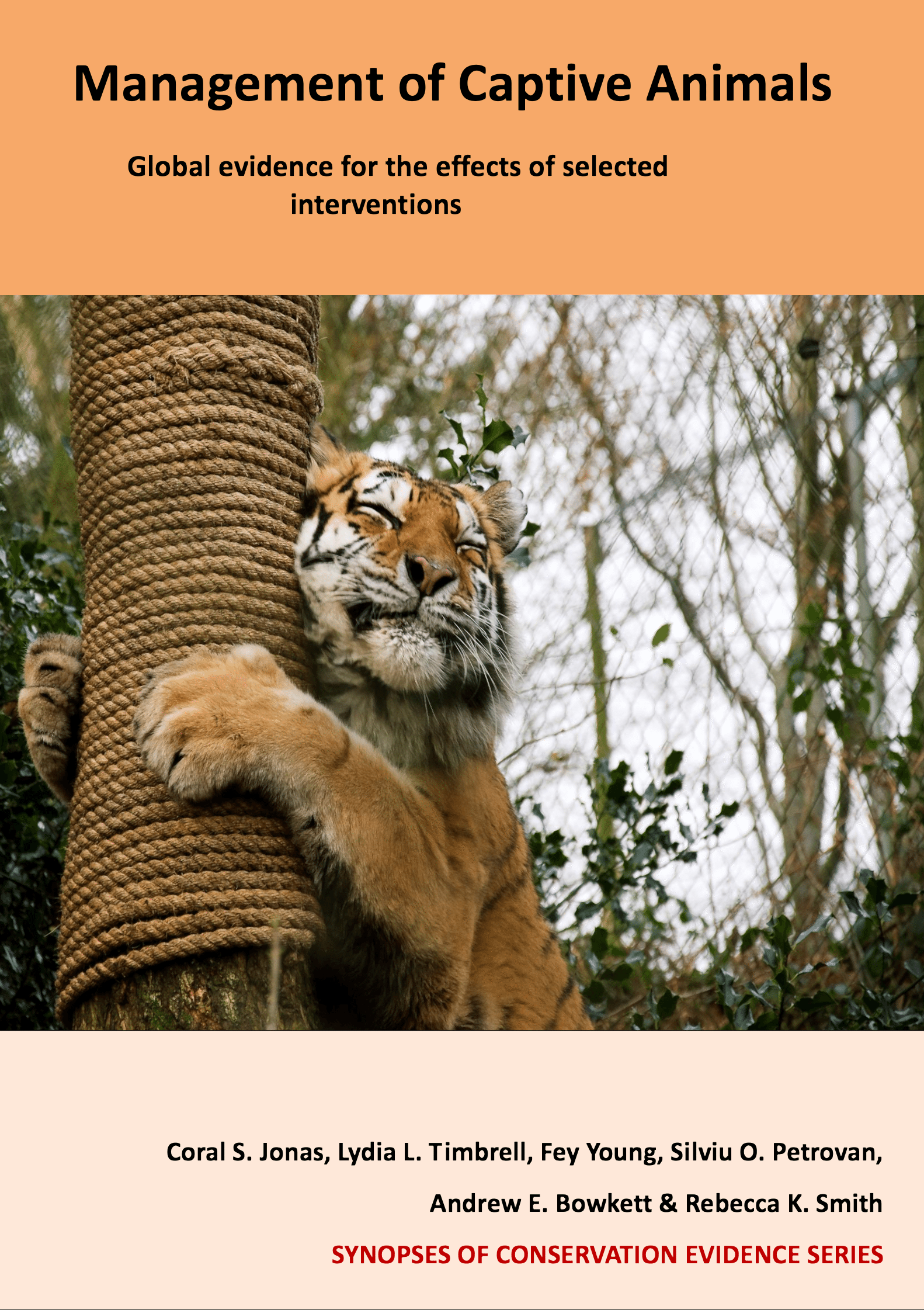Carnivores: Feed whole carcasses (with or without organs/gastrointestinal tract)
Overall effectiveness category Trade-off between benefit and harms
Number of studies: 6
View assessment score
Hide assessment score
How is the evidence assessed?
Effectiveness
80%Certainty
70%Harms
25%
Study locations
Supporting evidence from individual studies
A replicated, before-and-after study in 2002 of snow leopards Panthera uncia, leopards Panthera pardus and lions Panthera leo in three zoos in the USA found that when fed large carcasses, the frequency of off-exhibit feeding and natural behaviours increased and stereotypic behaviours decreased compared to when fed a commercial meat-based diet (mean values not reported). There were no differences in these behaviours on exhibit although hiding behaviour increased on-exhibit after carcass feeding. Nine felids were fed intact, eviscerated calf carcasses. Off-exhibit behaviour was recorded using a video camera starting immediately prior to provision of food. Twenty-four instantaneous scan samples were recorded over two hours per individual. Each animal received a carcass once every two weeks between 16.30 h and 17.00 h on scheduled days. On-exhibit behaviour was recorded by direct observation four times a day using instantaneous scan sampling every minute for ten minutes at each exhibit in 1.15 h rounds. Exhibit order was randomly selected.
Study and other actions testedA replicated, randomized, study in 1994 of ocelots Leopardus pardalis in three zoos in the USA, found that a diet of whole week-old chickens was lower in digestible energy and fat compared to commercial feline diet, whole mice, rat, rabbit, or quail and lower in dry matter digestibility compared to whole rabbit and quail diets. There were no other differences in energy, fat or protein digestibility between diets (mean values not reported). The diets did not differ in macronutrient content. Whole prey items may be more suitable for enrichment or supplementary feeding if their lower digestibility decreases the risk of overfeeding. Six ocelots in three zoos were fed once daily using six experimental diets: a commercial feline diet, adult mice, immature rabbits, immature rats, week-old domestic chickens and adult quail. Each ocelot received each diet for 1–3 trials in a random order.
Study and other actions testedA replicated, randomized, controlled study in 2012 of cheetahs Acinonyx jubatus in a safari park in Denmark, found that when fed whole rabbit, cheetahs had lower daily mean urea and zinc and higher vitamin A blood protein levels compared to being fed a supplemented beef diet. Cheetahs had a lower daily mean urea (12.8 mmol/litre) and higher vitamin A (96 ug/dl) blood protein levels when fed whole rabbit compared to being fed a supplemented beef diet (urea: 16.1 mmol/litre. vitamin A: 70 ug/dl). High levels of urea are potential indicator of chronic renal disease in captive cheetahs, but excessive vitamin A can result in skeletal deformities. Fourteen cheetahs, four housed individually and the rest group housed, were randomly assigned either a supplemented beef diet (1.2–1.6 kg/day/animal of chunk beef with 10 g/kg of multivitamin and mineral premix) or an un-supplemented whole rabbit diet (1.5–3 kg/day/animal). The cheetahs were acclimated to their diets for three weeks before blood samples were taken. Blood samples were collected from ten of the cheetahs. Three feed samples from both diets were collected for diet analysis.
Study and other actions testedA small, randomized study in 2013 of African wildcats Felis silvestris lybica in a zoo in the USA found that canned, dry extruded and whole one to three day old chicken diets had lower organic matter digestibility compared to a ground-chicken diet. Organic matter digestibility was lower when fed canned (87%), extruded (86%) or whole chicks (85%) compared to a ground chicken diet (94%). Canned and extruded diets met macronutrient and mineral recommendations for domestic cat foods and tested negative for all microbes whereas whole one to three day old chicken and ground chicken diets met macronutrient requirements for domestic cats but were below recommendations for some minerals and tested positive for potentially pathogenic microorganisms. If commercial diets are nutritionally similar to raw meat diets then they may be preferred to reduce the risk of pathogens. Four wildcats were each fed four chicken-based diets: whole one to three day old chickens, ground chicken, canned commercial diet and extruded commercial diet. Wildcats were fed daily on each diet for 16 days. Each diet was analysed and apparent total tract macronutrient digestibility was measured daily using food intake and faecal output.
Study and other actions testedA replicated, before-and-after study in 2014 of cheetahs Acinonyx jubatus in a safari park in Denmark found that when fed whole rabbit, the cheetahs exhibited lower faecal S100A12 (indicator of inflamed bowels) concentrations compared to when fed a supplemented beef diet. When fed whole rabbit, cheetahs had lower faecal S100A12 (301 ng/g) compared to a supplemented beef diet (1671 ng/g). There were no significant differences between diet groups for calprotectin or blood S100A12. Twelve cheetahs were part of a cross-over study which investigated the microbial fermentation of two diets. All cheetahs were fed a supplemented beef diet prior to the investigation. The two diets investigated were un-supplemented whole rabbit (2.5–3 kg diet/animal/day) or beef (1.2–1.6 kg diet/animal/day) supplemented with vitamin and mineral premix (10 g/kg meat). Ten of the cheetahs were anaesthetised as part of a routine veterinary procedure during the investigation and four blood samples from cheetahs fed whole rabbit and six from cheetahs fed supplemented beef were taken.
Study and other actions testedA replicated, before-and-after study in 2006 of tigers Panthera tigris and cougars Felis concolor in a zoo in the USA found that when fed carcasses on a bungee, pacing behaviour decreased and walking behaviour increased in cougars, while the frequency of pacing and other behaviours increased in tigers. In cougars, pacing behaviours decreased (6%) and walking behaviours increased (6%) when fed a carcass on a bungee compared to pre-enrichment (pacing: 32%, walking 2.5%). Tigers showed an increase in ‘other’ (aggressive, social, interactive, stalking and jumping) (15%) and pacing (8.5%) behaviours compared to pre-enrichment (other: 11.5%; pacing: 4%). Faecal glucocorticoid metabolites did not vary throughout the testing period. Four felids, housed in pairs were fed a skinned deer rump individually on a 120 cm bungee cord. Behaviour was recorded every two minutes using instantaneous scan sampling over three hours, during pre- and post-treatment. Prior to enrichment felids were feed a routine commercial, supplemented diet. Faecal samples were collected once a week for four months prior to treatment and twice a week from first treatment until one week after the second treatment.
Study and other actions tested
Where has this evidence come from?
List of journals searched by synopsis
All the journals searched for all synopses
This Action forms part of the Action Synopsis:
Management of Captive Animals
Management of Captive Animals - Published 2018
Captive Animal Synopsis




















